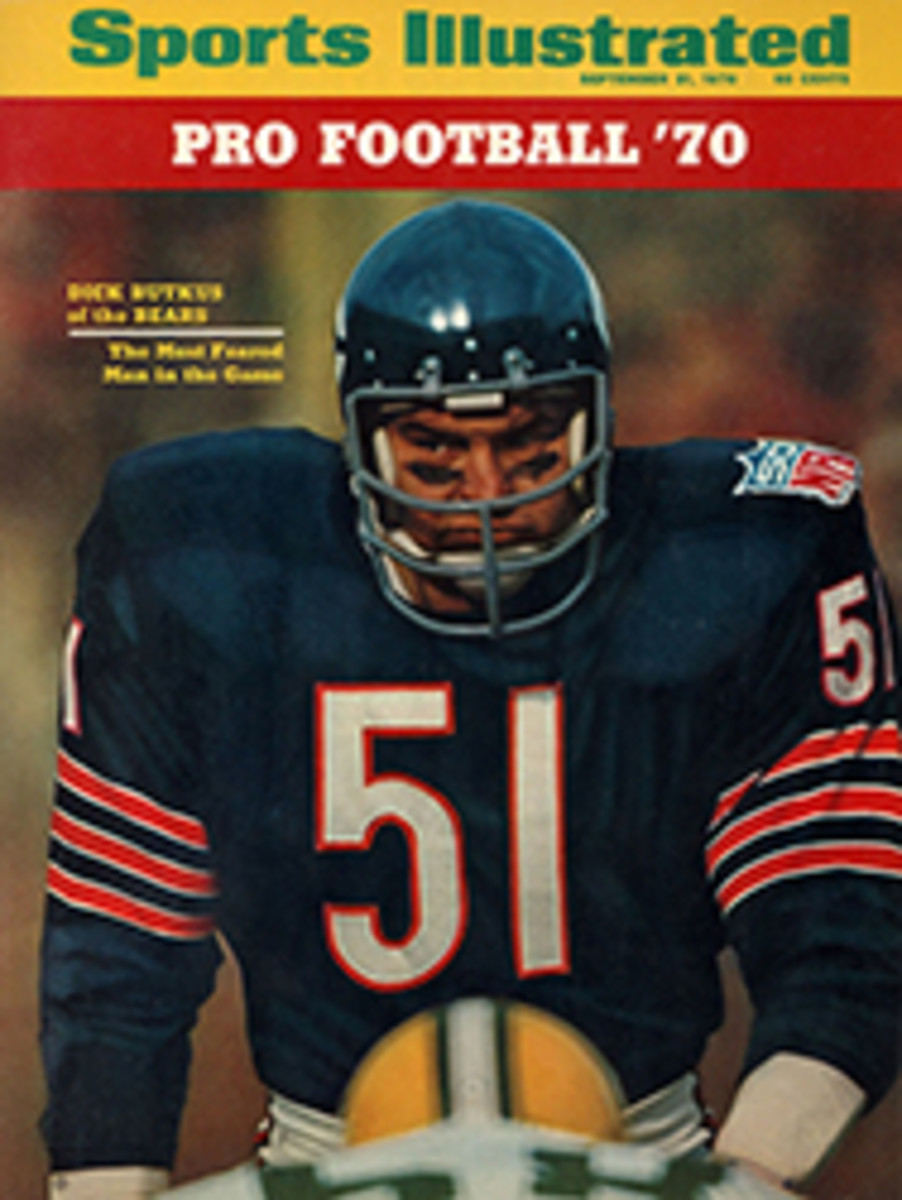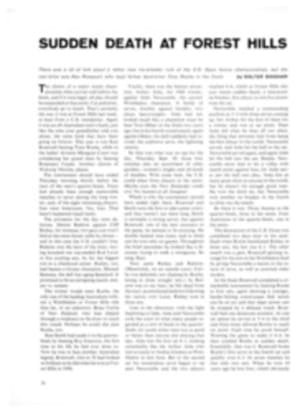
EATING HIGH ON THE HOGS
The whole thing bore a quality of unreality from the beginning, what with the game being a twi-night singleheader to avoid a television matchup with Miss America. This was the start of a new college football season, and this game down in Little Rock paired the odd couple: Stanford, which claims to be an Ivy-type institution, and Arkansas, which gets accused of being a football factory. They had nothing in common except good teams, a couple of quarterbacks who were supposed to be in the running for the Heisman Trophy, and a willingness to play an extra game, an 11th game, for money.
Then came this outrageous early outburst by cool and relaxed Jim Plunkett and Stanford to run up a 27-0 lead over a confused, unrelaxed—and favored—Bill Montgomery and Arkansas. And then came the first black athlete ever to play for Arkansas, a quick little dandy named Jon Richardson—yep, a Negro, right there in Orval Faubus' place of business—to provide the spark for a Razorback comeback that almost won the ball game, and at least erased the embarrassment of it all.
And, finally, Stanford overcame an old habit it had of blowing things and got out of these wild and unlikely surroundings with a melodramatic 34-28 victory. Jim Plunkett didn't choke, even when Arkansas started creeping up, and for once neither did his defense. When last seen, the Indians were celebrating with a midnight swim in a motel pool and looking forward to a Sunday-night stopover in Las Vegas, no doubt having visions of Plunkett putting wheels on the Heisman Trophy and driving it into Pasadena on New Year's Day.
If such things come to pass for the long-suffering folks from Palo Alto, Plunkett and all of the other Indians ought to let the procession be led by a couple of guys named Jeff Siemon and Mike Simone. They happen to be Stanford linebackers. They happen to be the guys who made the great big game-saving, Heisman-saving (if you will) plays at the furious finish when all 48,000 in Little Rock's War Memorial Stadium-including, perhaps, Stanford Coach John Ralston—absolutely knew that Arkansas was going to score somehow and win the game 35-34.
Despite the fact that Plunkett, who can make third down look like a birthday cake—he did eight times, anyhow—had given Stanford that four-touchdown lead, and despite the fact that the Razorbacks had often resembled some of those Wichita States they play, the game was there for Coach Frank Broyles' team to win at the very last. Forget everything else, the ease with which Plunkett had picked Arkansas apart and the bizarre moments in which Arkansas had staggered back—with end-around plays, with Jon Richardson's catching and running, with Broyles desperately going at times with sophomore quarterback whiz Joe Ferguson (whom he had hoped to red-shirt). Forget all that.
The Razorbacks somehow have the ball on Stanford's five-yard line, needing two measly yards for a first down—recovering a fumble at midfield had given them this last chance—and just those other measly three yards on the bright Astro Turf for the tying touchdown. Then if Bill McClard couldn't boot the winning conversion, there were no catfish in the White River. And Stanford would lose again like it did to Purdue and USC last year, with big Jim Plunkett helpless by the sideline, and with the defense coughing so loud that Stanford fans would feel an urge to call time and send in throat lozenges.
So this was it. But with "Whoooo, pig, sooey" ringing into the hot, humid night (the first half had been played in the hot, humid late afternoon), bounding Bill Burnett, Arkansas' best runner, got exactly zero on a bolt into the right side of his line. Bill Burnett usually leaves cripples behind him, but Stanford's middle linebacker, Jeff Siemon, a 220-pound junior from Bakersfield, met him head-on. Burnett wiggled crazily in the air for an instant at the moment of impact, outstretched, like a diver who had forgotten whether it was going to be a gainer or a flip. Nothing. He went nowhere.
Now it was fourth down and still two yards, perhaps a long one-and-a-half. Arkansas time-out. Twenty-nine seconds left. Ball still on the five or a few inches inside it. Bill Montgomery came to the sideline and conversed with Frank Broyles. It had to be a sprint-out option. Bill would look first for Chuck Dicus, his fine receiver. He had managed to find him once for a touchdown, at least. He would look for Dicus, but cut and run if daylight appeared. All he wanted was two yards. He got one.
When Montgomery, who had been demoralized at times by a Stanford rush but more so by his own atrocious passing, looked for Dicus as he darted out to his left, he found him covered by Stanford's Ben Barnes. So he turned to run. But up came the other linebacker, Mike Simone. Mike smacked Montgomery down with a considerable amount of authority, and everyone could plainly see that Arkansas hadn't made it; that, indeed, the game had been won by the team that appeared to have won it much earlier, and probably deserved it.
Those who think the 11th game is new to college football have not studied their history. Back in the middle 1930s in the Southwest, part of the South and part of the West, there were teams taking on as many as 12 foes in the regular season. A long, long time ago, of course, the powers of the game, the Ivies of the 1890s, rarely played fewer than 13 games in a season and often as many as 16. They frequently challenged two and three colleges in a single week.
Arkansas' Frank Broyles, ironically, was one of the real forces behind the new rule permitting 11 games. Every school needs money, he argues, and an extra game could add maybe as much as $200,000 in revenue. Frank also used the 11th game to beef up a schedule that is often criticized. Next year Arkansas plays California and for two years after that the Razorbacks have none other than USC.
If the Little Rock game got a good rating, it wasn't because it was a big quarterback shoot-out, as predicted. Plunkett made it a fairly one-sided show. There were times when no quarterback, ever, could have looked better. He devoured a good defensive football team—and sometimes a great one—mainly with short, dump passes out to the side and over the middle to his backs, and with flares and screens, exhibiting his remarkable ability always to find the "hot" receiver, as Stanford calls the open man, or the "cheap" receiver, as Arkansas calls him.
Discovering that the Arkansas defense was Plunkett-conscious, Jim took advantage of it by sending his tough fullback, Hillary Shockley, off the flanks and against the innards of the Razorbacks for 117 yards, including a 43-yard romp for the game's first touchdown.
Plunkett hit 22 of 39 passes for 262 yards and one touchdown. His statistics might have been better—not that those are exactly embarrassing—if he hadn't had a "tired" second quarter, when he went 3 for 13. He said he not only got tired but the humidity, to which he was unaccustomed, made his hands sweat and he couldn't control the ball so well.
No opponent had ever gotten a Broyles team down by four touchdowns in Arkansas, but more bothersome to the Razorbacks was how horribly easy it had seemed. No matter where Stanford started from, whether 80 yards away or something less, Plunkett just moved the Indians as if he were opening against San Jose State again. But he had done this last season, too, against strong teams, in what John Ralston calls "the year that might have been." Plunkett had Purdue stunned 35-21, but Stanford was beaten. And he had USC in shock 12-0, but Stanford lost on the last play of the game. And he had UCLA dizzy by 17-6, only to get no better than a tie. Thus Stanford was 7-2-1 on a season that could have been 10-zip. Last week, however, might have been the start of The Year That Is.
"Our defense finally came of age," said Ralston.
Frank Broyles, meanwhile, will search long and hard to try to figure out what happened to his Razorbacks. They clearly weren't themselves as they stood around on defense for a whole half, nor as Bill Montgomery woefully missed the first seven passes he threw, and 11 of the first 12, and was so ineffective that Broyles grudgingly sent in Joe Ferguson, the highly prized rookie from the same Shreveport high school that gave the world Terry Bradshaw.
It was Ferguson, a whip-arm thrower, who got Arkansas moving for its first touchdown, and then it was the other sophomore, the surrealistic Jon Richardson, who chased down a 37-yard wobbler of a pass from Montgomery for the score that gave Arkansas some reason for hope. It was this catch that narrowed the margin to 27-14 at the half.
It went back to 34-14 right away, but Dicus caught an eight-yarder from Montgomery for one Arkansas touchdown and then Richardson, the son of a postman in Little Rock, went back into action. He took a screen pass, dancing and ducking 17 big yards, to set up the Arkansas score that drew the Razor-backs within six points toward the end.
Arkansas might have considered using Richardson there at the last, using him to do something. He might have won it, somehow, catching or running. It would have done even more wonders for Arkansas integration. But perhaps he did enough as it was, and, after all, it really had been Jim Plunkett's game all the way.
PHOTO
HEINZ KLUETMEIER
The play that could not be stopped, but was: Arkansas' Bill Montgomery is felled on fourth and two, with victory in his grasp, by Mike Simone.
TWO PHOTOS
HEINZ KLUETMEIER
Plunkett put Stanford up enough to survive moves like Jon Richardson's TD reception.

